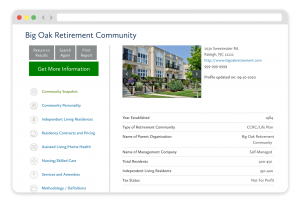We often write about the goal of many older adults to remain in their current homes as they age, sometimes referred to as aging in place. We also discuss the hurdles sometimes faced by those who either make this senior living decision or lack the resources to consider alternate options: availability of paid or unpaid caregivers, health and safety issues, anxiety, just to name a few. But of course cost is almost always at the top of this list. That’s why a recent survey about access to home- and community-based services (HCBS) was particularly insightful.
What are home- and community-based services?
Home- and community-based services (HCBS) refer to a range of support services designed to help older adults (as well as individuals with disabilities) live independently and remain in their homes or communities, rather than in a group care setting like an assisted living community or a nursing home or even a hospital.
These services are usually tailored to meet a person’s unique needs. Therefore, HCBS can include a wide variety of support options, such as:
- Assistance with activities of daily living (ADLs) like bathing, dressing, meal preparation, and/or medication management
- Respite care for family caregivers
- Home modifications to ensure safety and accessibility
- Transportation assistance for medical appointments or social activities
- Case management to coordinate care
- Therapeutic services like physical or occupational therapy
- Support for managing chronic conditions
HCBS facilitate autonomy and can often improve older adults’ quality of life by allowing them to maintain their relationships, routines, and familiar environments, all of which are crucial for mental and emotional well-being. By offering flexible care options in the home or community, HCBS also can significantly reduce the need for institutional care, which often involves higher costs, and also requires the older adult to relocate, which they may find upsetting and stressful in some situations.
>> Related: 3 Reasons Why Aging in Place May Not Be Cheaper
Meeting care goals and preferences
In recent years, HCBS have gained importance in long-term care policy as the preference for aging in place and community-based care has grown. This shift to more HCBS care delivery also aligns with broader senior living industry trends emphasizing “person-centered care,” which prioritizes the preferences, values, and goals of the individual when planning and delivering needed services.
As a result of this evolution in preferences and philosophies, options for HCBS have been increasingly implemented by retirement communities — in particular continuing care retirement communities (CCRCs, also called life plan communities) — as they look for ways to meet the needs of current residents and, in some cases, their surrounding communities.
To get a better handle on the current HCBS landscape, in November of this year, Zeigler, a Chicago-based specialty investment bank that focuses on the healthcare, senior living, and education sectors, conducted their first CFO Hotline Survey (PDF), seeking feedback on HCBS from CFOs within the senior living space.
>> Related: Remain in the Home You Love: The Continuing Care at Home Model
The home- and community-based services landscape
Nearly 200 organizations participated in the Zeigler survey, with approximately 120 of those organizations offering HCBS. Respondents were primarily from single-site not-for-profit CCRC/life plan community organizations (53.6%); around 30% were from providers with multiple sites located within the same state. Among the survey’s key findings:
- Over 60% confirmed that their organization(s) provide home- and community-based services. More specifically, the HCBS they offer include options like:
- 68.6% home care
- 43% home health
- 32% hospice
- 21.9% continuing care at home (CCaH or “CCRC without walls”)
- 11.7% adult day care
- The highest number of respondents offering HCBS were located in the South (57%), followed by the West (18%), Midwest (15%), and Northeast (10%). Interestingly, however, Pennsylvania was the state with the most HCBS participants overall.
- Single-site CCRC/life plan communities comprised a dominant 47.9% of HCBS offerings, followed by multisite/same state providers (38.5%).
- Among those offering HCBS, over a third (34.4%) have been providing such services for more than 15 years, but nearly half (46.8%) have offered them for 10 years or less.
- Among the providers that do NOT currently provide HCBS, 68% said they had no future plans to, yet among the other ~30% that do plan to begin providing such services, half plan to begin within the next 24 months.
>> Related: A Break for Family Caregivers: Adult Day Care and Other Respite Care Options
Options to address older adults’ financial constraints
The CFO Hotline Survey also delved into where, how, and why senior living communities are providing HCBS to older adults.
Where: The vast majority (85.5%) provide such services on-site within their retirement community, 71.8% provide in-home care, and 20% deliver HCBS to local nursing centers.
How: The HCBS being provided by these organizations is delivered by an array of healthcare providers and caregivers. However, the vast majority (86.3%) are utilizing their own nursing and care staff.
Why: A large majority of respondents (79.7%) cited the growing demand for home- and community-based services. Others saw it as an opportunity to expand their organizations’ mission (70.7%) or complement existing service offerings (69.9%). Revenue diversification (54.5) and outreach to their local community (44.7%) were also key reasons for implementing these services.
Notably, a few survey respondents also mentioned additional motivations for providing HCBS, such as using them to accommodate assisted living residents who had depleted their financial resources and could no longer afford on-site long-term care (18.7%). This is a key point that the senior living industry as a whole should take to heart.
Older adults who fall into the middle market often lack the funds needed to move to a retirement community or may run out of money while receiving necessary long-term care within a senior living and care community. The increasing availability of HCBS provides low- and middle-income senior adults with another, often more affordable option to receive the care services they require while remaining in their current home. It may also allow them to afford care on their own without having to qualify for Medicaid.
>> Related: Outside-the-Box Solutions for Middle-Market Senior Living
The more care options, the better for everyone
There are pros and cons to nearly any senior living and care option — often related to cost, quality, location, individual needs and preferences … or some combination of these. This goes for those receiving home- and community-based services in their home too. For instance, if a higher level of care is needed than can be safely provided in one’s home, the older adult may be required to relocate to an assisted living community, nursing home, or hospital.
But, as we see from the Zeigler CFO Hotline Survey, more and more senior living communities are coming up with innovative alternatives to living in a retirement community. For many providers, that solution is HCBS.
By offering home- and community-based services, retirement communities, such as CCRCs, are able to help keep seniors healthy and living independently for as long as possible while still meeting their care needs, honoring their personal preferences, and respecting budgetary constraints.
While the Zeigler survey found that 69% of respondents reported revenue of less than $10 million from their HCBS, such programs generated over $10 million for the remaining 30% of organizations (and over $100 million for 6.9% of respondents’ organizations!). As such programs grow in number and scale, it’s clear that they can be a win-win for both providers and older adults.

FREE Detailed Profile Reports on CCRCs/Life Plan Communities
Search Communities






